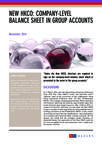
New HKCO: Company-level balance sheet in group accounts
Background
On 3 March 2014, the new Hong Kong Companies Ordinance (Cap. 622) (the “New HKCO”) came into operation which replaces most of the provisions of the predecessor Hong Kong Companies Ordinance (Cap. 32) (the “Predecessor HKCO”). The changes introduced by the New HKCO relating to the financial reporting and auditing requirements apply only to the financial years beginning on or after 3 March 2014. In respect of financial reporting, not only does the New HKCO bring in a number of new requirements, it also modifies certain existing provisions of the Predecessor HKCO. In this article, we will look at one of the key modifications – the presentation of a company-level balance sheet in group accounts. At first glance, you might find the changes simple. However, as explained below, the application of the New HKCO could be far from straightforward and compliance with it might even be counter-intuitive.
What are the existing financial reporting requirements?
Under the Predecessor HKCO, when a HK-incorporated holding company prepared group accounts, its company-level profit and loss account was no longer needed. However, the holding company was still required to satisfy the relevant provisions of the Predecessor HKCO in relation to the preparation of its company-level balance sheet, which included giving a true and fair view of its state of affairs and complying with the applicable disclosure requirements. There has been no specific accounting framework promulgated by the HKICPA designed specifically for the presentation of a balance sheet on a standalone basis. However, it has been generally accepted that in order to achieve such a true and fair view, the company-level balance sheet had to be prepared in accordance with the requirements of the applicable accounting standards in relation to the balance sheet as a whole and the items therein. In other words, the company-level balance sheet was presented as a primary financial statement accompanied by explanatory notes.
What are the new financial reporting requirements?
The New HKCO introduces the following significant changes in the presentation of the company-level balance sheet:
- It is not required to give a true and fair view.
- It is presented as part of the notes to the group accounts.
- It is not required to contain any notes except for the movement in the holding company’s reserves.
Does the New HKCO specify on which accounting framework the company-level balance sheet should be prepared?
Schedule 4 to the New HKCO only requires that the company-level balance sheet must be in the format in which that balance sheet would have been prepared if the holding company had not been required to prepare any annual group accounts for the financial year. Moreover, the company-level balance sheet is no longer required to show a true and fair view. Instead, it forms part of the group accounts in which it is included. The answer to the question is just a legal matter. However, it seems logical to apply the same accounting framework adopted in the group accounts to the company-level balance sheet, even though the accounting standards promulgated by the HKICPA are silent on this matter.
Under the New HKCO, is it allowed to keep presenting the company-level balance sheet as a primary financial statement instead of moving it into the notes to the group accounts?
No. Companies are not given a choice as to where the company-level balance sheet is presented. It must appear in the notes to the group accounts. Similarly, in a situation where a full set of group accounts and a full set of company accounts are presented in the same document on a side-by-side basis (i.e. column by column), the company-level balance sheet, which is presented as a primary financial statement in the full set of company accounts, has to be presented again in the notes to the group accounts in accordance with the New HKCO if the group accounts are the statutory accounts. Put another way, the company-level balance sheet will appear more than once in the same document in such a circumstance.
When the group accounts are prepared in accordance with the Small and Medium-sized Entity Financial Reporting Standard (Revised 2014) (“SME-FRS”), is it required to present the company-level balance sheet in the notes to the group accounts?
Yes. The requirement under the New HKCO applies to all HK-incorporated companies no matter whether they fall within the reporting exemption. In fact, the same requirement has been incorporated into SME-FRS.
Is the company-level balance sheet subject to the same approval and signature requirements as the group-level balance sheet?
Under the Predecessor HKCO, both the company-level and the group-level balance sheets had to be approved by the board of directors and, normally, signed on its behalf. The New HKCO has similar provisions which stipulate that a balance sheet that forms part of any financial statements must be approved by the board of directors and signed. In addition, every copy of such a balance sheet laid before a company in general meeting, or sent to a member or otherwise circulated, published or issued by the company, must state the name of the person who signed the statement on the directors’ behalf. Therefore, under the New HKCO, the company-level balance sheet, even though it is presented in the notes to the group accounts, has to go through the same approval and signature process as if it were a primary financial statement.
When an accounting policy is applied retrospectively with a material effect on the third company-level balance sheet, is it required to present the third company-level balance sheet in accordance with Hong Kong Accounting Standard (“HKAS”) 1?
HKAS 1 defines the skeleton of a complete set of financial statements and this principally includes four primary financial statements and explanatory notes. It seems that the third-balance sheet requirements under HKAS 1 apply only to the balance sheet that is presented as a primary financial statement.
Is the auditor still required to determine materiality for the company-level balance sheet as a whole?
No. Since the company-level balance sheet forms part of the group accounts, the auditor is only required to determine an overall materiality level for the group accounts in accordance with Hong Kong Standard on Auditing (“HKSA”) 320. However, this does not preclude the auditor from determining, if necessary, a specific materiality level to be applied to the company-level balance sheet which is included in the notes to the group accounts.
Will the change in presentation location eliminate the auditor’s consideration for an emphasis of matter paragraph in relation to the company-level balance sheet?
No. The location of the company-level balance sheet is not a relevant factor for the auditor to consider whether an emphasis of matter paragraph should be included in the auditor’s report in accordance with HKSA 706.


